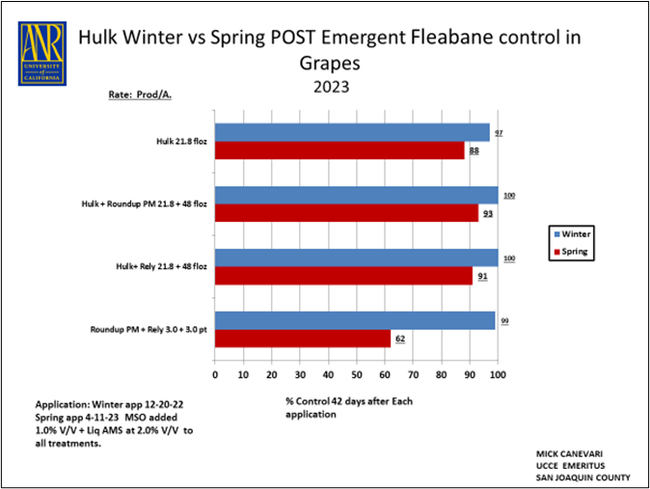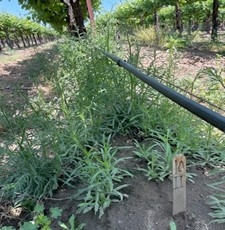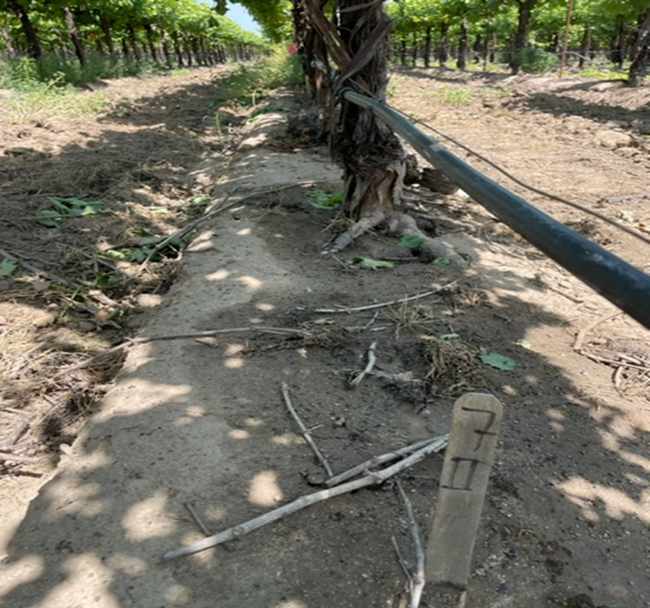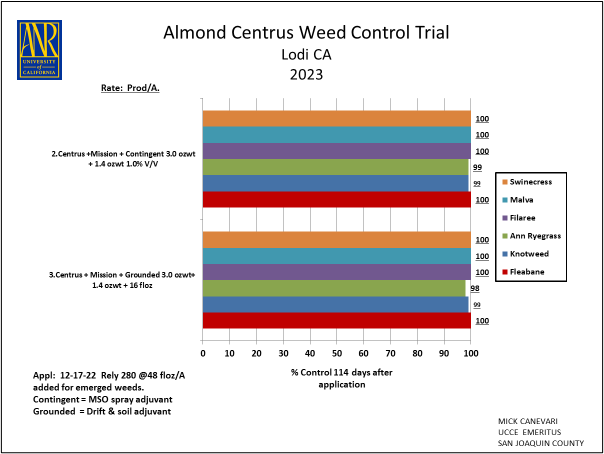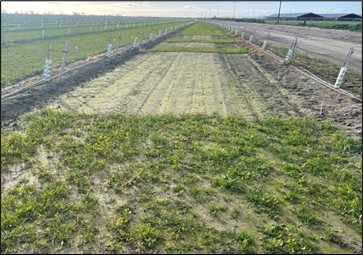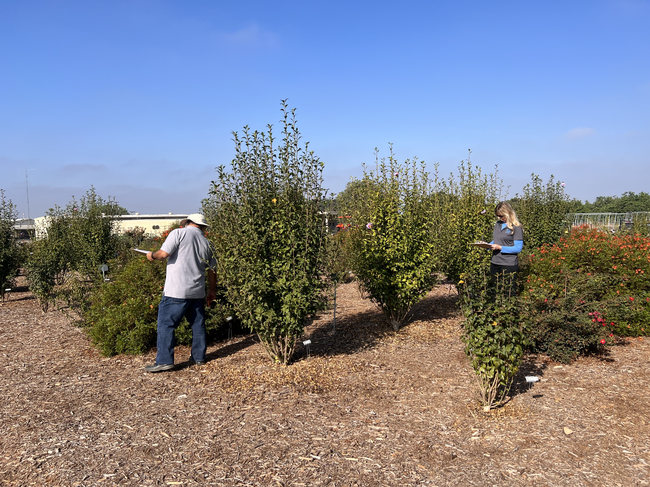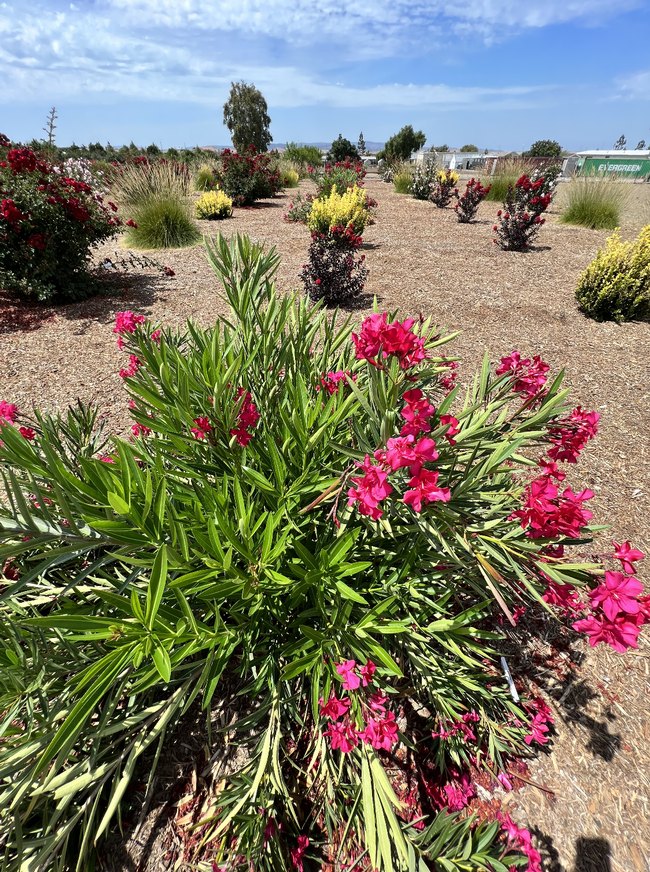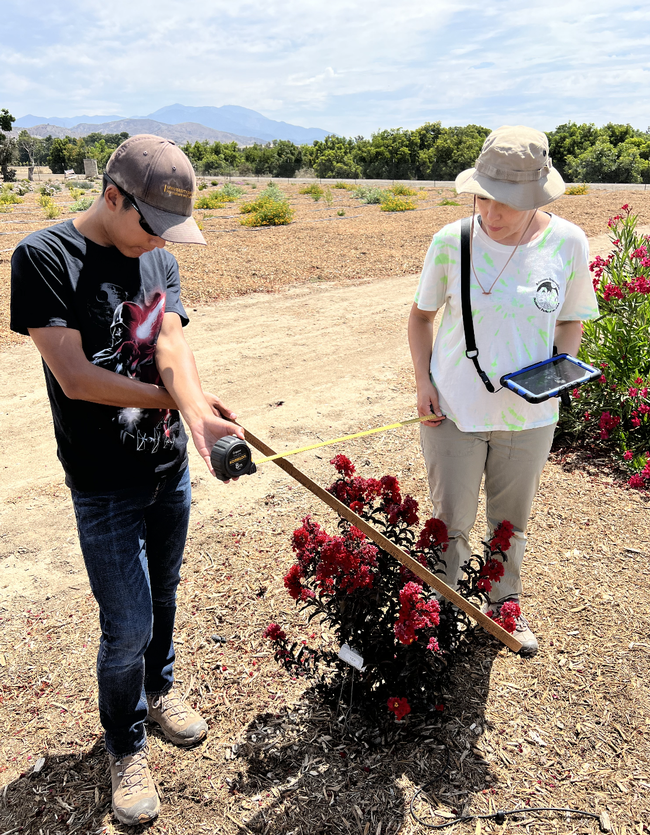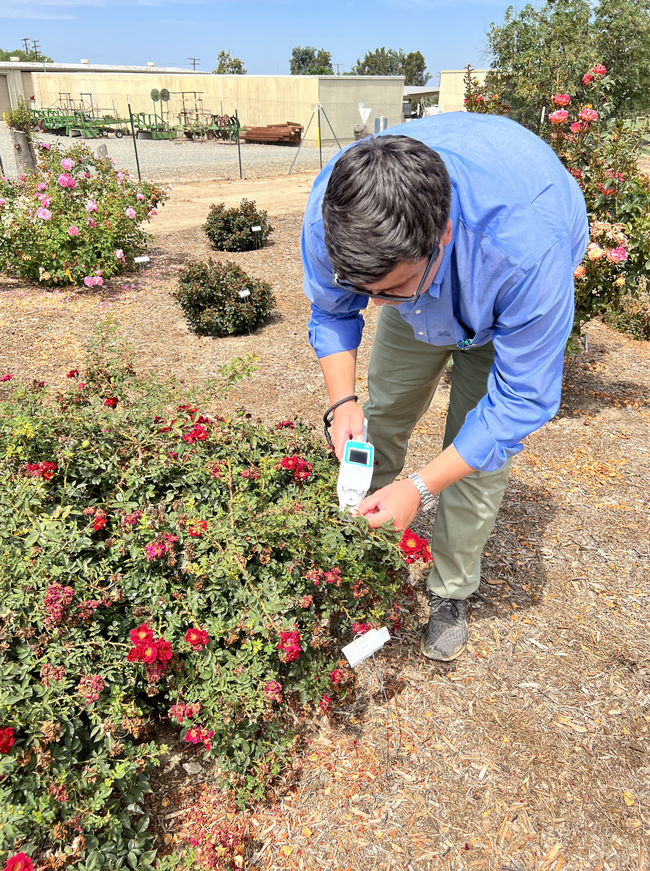Posts Tagged: herbicides
New herbicides bring additional tools to California rice weed management in 2024
This year brings several new chemical tools to California rice. With many herbicide-resistant species as well as emerging problematic weed species, the new chemistries are a welcome tool for managing resistance and preventing the selection of resistant...
Fall Weed Control
These are notes from Central Valley nut and grape advisors, but the comments are valid for most citrus situations. As we all know, follow pesticide labels and make sure the material is valid/legal for your situation.
- Author: Mick Canevari
- Author: Brent A Holtz
- Posted by: Gale Perez
The 2023 post-harvest season is upon us and it's time to prep for your fall/winter weed control activities. The long-range forecast is calling for another wet winter, and November is the ideal time to plan your early winter weed control program, to check that your spray equipment is functioning properly and calibrated, and to clean your orchard floor of nuts and debris.
There are a variety of herbicides available today for our tree and vine production systems. No one herbicide will control all the weeds present, but choices exist to achieve excellent control for almost every weed combination. However, it takes patience and persistence to win the weed war. Before programs are decided, the following key questions should be discussed with your pest control adviser (PCA). Tree age, root stock, soil composition (sand, clay, gravel), irrigation design and practices, water source and quality, cultural practices used, a list of weed species present, and whether they are annual, biennial, or perennial weeds, your spray nozzle design, spray volume required, and if there are sensitive crops nearby. Discussing these questions early will provide the basis for your PCA to make the best recommendations possible while allowing your applicator to minimize the risk of crop injury or drift issues.
Advantages of early weed control
The advantage of implementing an early pre-emergent herbicide program, “before leaf fall occurs” is to get a jump start on winter germinating weeds at a time when they are just emerging and susceptible. Applying a pre-emergent ahead of a rain, or by activating with sprinklers, will control millions of weed seeds and provide a clean tree row for 4-6 months into spring. Applying a pre-emergent ahead of leaf drop also eliminates an additional operation of sweeping or blowing leaves after leaf drop has occurred. Weed control is enhanced and herbicide efficacy is extended when the herbicide is already in place before leaves cover the soil. A leaf barrier after an application inhibits weed germination and improves herbicide efficacy. As more orchards and vineyards turn to drip irrigation, relying on rain events to set herbicides becomes critical. A weed management program applying soil active herbicides early in the fall (November/December), and repeated in spring while rain events are still forth coming (March/May), will provide good weed control into summer. Orchards with sprinkler irrigation have more flexibility in timing their applications and selecting herbicides.
Pre-emergent herbicide use is also a recognized strategy to manage herbicide resistant weeds that have become established. We hear complaints every year that post-emergent herbicides are failing to control the same weeds they used to; and that higher application rates are needed to achieve the same level of control. Some of our more frequently used herbicides are developing weed resistance in the field: they include; glyphosate, paraquat, sethoxyodim, clethodim, rimsulfuron and other related acetolactate synthase (ALS) inhibiting herbicides.
Herbicide resistant weeds continue to spread across the state in different cropping systems, with the greatest occurrence in perennial orchards and vineyards. Problematic weeds include annual ryegrass, junglerice, goose grass, hairy fleabane, palmer's amaranth and horseweed or marestail with several other annual weeds close behind in developing resistance. There are several approaches to control these resistant weed species--but the best option by far is starting with a pre-emergent herbicide program early and attacking weed seeds at the point of germination.
New herbicides expected in 2023-2024
We are always anxious to share information from our various weed and herbicide research trials. But we never know for certain when a new herbicide will be registered for use in California. Two new herbicides are expected to be available this coming season, Florpyrauxifen-benzyl and a combination product with Indaziflam and Rimsulfuron.
Hulk (florpyrauxifen-benzyl) is a post emergent synthetic auxin mode of action HRAC (herbicide resistance action committee) group 4 herbicide from Corteva Agriscience. It is a foliar uptake and systemic herbicide that translocates through the phloem and xylem accumulating in meristematic tissue. It exhibits herbicidal symptoms of twisting and epinasty, typical of phenoxy herbicides. It targets many broadleaf weeds, typical of phenoxy herbicides, but with greater efficacy with certain weed species. Symptoms develop rapidly when plants are actively growing, but whole plant death may take several weeks to a month depending on the growth stage and environmental conditions. Currently, labeled crops include pome, stone, citrus and tree nuts. Grapes are being explored and may be added to the label in 2025. Tank mix partners are needed for emerged grasses which may include the use of glufosinate, glyphosate, clethodim and some ALS herbicides with post grass activity. Generally, one should avoid using contact herbicides that readily burn leaf tissue, like “paraquat” for example, since they may inhibit foliar absorption and systemic movement needed to control the weed. Check the label for specific recommendations.
Centrus (Indaziflam + Rimsulfuron) is a pre-emergent herbicide from Helena Agri company packaged with two active ingredients and modes of action herbicides in HRAC group 29 & 2. Centrus will provide long term pre-emergence control over a broader spectrum of weeds and grasses. It is labeled for tree fruit, nut, and vines for residual weed control targeting winter and summer annual weeds common in orchard and vineyards, including annual ryegrass, filarees, fleabane-horseweed, malva, shepherd's purse, willowweed, knotweed, and many more. In all cases it will be necessary to add a post emergent herbicide for emerged weeds. By combining two active ingredients with different mode of actions, it broadens weed control across more species while slowing herbicide resistance to either active ingredient. We need to be mindful of mixing different modes of action herbicides and not using the same herbicides repeatedly. By mixing different mode of action herbicides we strive to keep our products viable for years to come.
Overview of pre-emergent (before weed germination) herbicides currently registered
Craze (orthosulfamuron) HRAC Group 2 is a new 2022 broad-spectrum soil residual herbicide from Nichino America. The active ingredient in CRAZE is orthosulfamuron. This herbicide, an acetolactate synthase (ALS) inhibitor, works by inhibiting the enzyme responsible for the production of amino acids (valine, leucine, and isoleucine) essential for plant growth. CRAZE has demonstrated broad spectrum residual control of many broadleaf and grassy weeds including horseweed and fleabane and suppression of yellow nutsedge if applied in a timely pre-emergent manner. Several years of testing has demonstrated that it will fit into our Tree and Vine weed control program with flexibility and safety. In our testing, it included tank mix combinations with Alion, Chateau and Prowl which extended long-term control.
Prowl H2O and Surflan (pendimethalin & Oryzalin) are HRAC group 3 herbicides that have excellent annual grass control along with many broadleaves, especially those that germinate in the spring and summer. Surflan and Prowl are of the same mode of action and are similar in their weed spectrum and residual properties. Prowl H2O and Surflan remain stable on the soil without moisture no more than 21 days. Prowl is in the DNA family which controls weed seeds once the germination begins by inhibiting meristematic growth and plant cell division or mitosis, inhibiting seedling development. A common weed control strategy in the fall is to use a mode of action herbicide such as Chateau, Matrix, Alion, Pindar GT, Craze, and then switch to the DNA chemistry of Prowl/Surflan in the late winter or spring timing (February to May) to control summer annual broadleaf weeds and grasses. Prowl is an herbicide used for newly planted orchards because of its strong affinity of soil binding properties and safety to young trees. Prowl may be used before or after transplanting nonbearing nut and fruit crops and roots are covered with at least 2 inches of soil. Always follow the label instructions.
Chateau EZ (flumioxazin) is now in a new liquid formulation. Fortunately, the use rates and product rates for the new formulation remain the same, so the conversion from granular to liquid also remain the same. It is HRAC group 14, a long-lasting pre-emergent herbicide used for tree, nut, and vine crops. Applied between 8 -12 ounces per treated acre, Chateau enhances burndown of small broadleaf weeds and provides long residual control of difficult to control weeds such as fleabane and horseweed (marestail), malva, willow weed, filaree and a host of other winter weeds. Its broad-spectrum control of winter annuals makes it an excellent herbicide for use in the fall and early winter timing during the dormant period. Chateau at lower rates (6-8 ounces) has become a popular tank mix with other pre-emergent herbicides to extend control of more grass species and slow herbicide resistant issues. New Plantings: Chateau EZ provides early protection of new plantings from weeds. It can be applied immediately after planting according to label guidelines. Trunk protectors are required.
Matrix (rimsulfuron) HRAC group 2 is an ALS inhibitor pre-emergent herbicide active on many winter and summer weeds including fleabane, willow weed, and marestail, barnyard grass, jungle rice, crabgrass. Its broad-spectrum activity on grasses and broadleaf weeds, make it a good fit for an early fall application timing in November or December. It has become a popular herbicide to manage glyphosate resistant ryegrass pre-emergent and is effective post emergent on small emerged ryegrass. We have observed nice broad spectrum weed control when other pre-emergent herbicides are combined with Matrix. A post emergent herbicide should be added when weeds are emerged. Matrix is safe on young trees and a popular tank mix with Prowl or Trellis.
Mission (Flazasulfuron) is a HRAC group 2, an ALS inhibitor in the same family as rimsulfuron, orthosulfamuron (Matrix, Craze) with a similar weed spectrum. Our research has shown that Mission increased post emergent activity on certain weeds at a rate of 2.14 ounces per acre. Research from other Farm Advisors suggests improved yellow nutsedge activity when applied ahead of emergence with adequate water for soil incorporation. Use a post herbicide as a tank mix partner when weeds are up.
Alion (indaziflam) is a broad spectrum pre-emergent soil active herbicide registered in tree nuts and vines. It is a long-lasting soil residual herbicide exceptional in controlling many grasses and broadleaf weeds. It is effective on both winter and summer annual weeds, including fleabane, marestail, sowthistle, and willow weed, shepherd's purse, chickweed, and most grasses. At least 1/4 inch of water is needed to set and activate Alion as a soil residual. Since it is strictly a pre-emergent herbicide, it requires a tank mix with a post herbicide for emerged weeds, typically Rely, Matrix, Shark, Goal, Roundup, Venue, Treevix and Gramoxone are all compatible. Alion has shown to be an excellent tank mix partner with other pre-emergent herbicides to increase its weed spectrum, especially for malva and knotweed. Since it does not control weeds already germinated or just under the soil surface (called white phase) it should be tank mixed with herbicides that will control weeds just prior to emerging (Matrix, Mission, Pindar Gt or Goal are some popular choices).
Pindar GT (oxyfluorfen and penoxsulam) HRAC group 14 & 2 is a premix with two active ingredient herbicides. It combines both a pre- and post-emergence punch for many broadleaf weeds used in tree nuts and fruits but not registered in vineyards. An excellent herbicide for winter applications beginning in November to January, that can provide residual control lasting into spring and early summer. It is especially effective on fillaree, malva, henbit, willow weed, sowthistle, fleabane and marestail among others. If weeds have emerged, it is still recommended to combine it with a post emergent herbicide such as Roundup, Rely, or Gramoxone. If heavy grass pressure is anticipated in the orchard, an addition of Prowl, Matrix or Alion will extend long term grass control into spring. Within 14 days of application, a half-inch of water is needed to set and activate the herbicide.
Trellis (isoxaben) HRAC group 21 is registered for use in tree nut and fruit crops and for non- bearing newly planted orchards (check label for specific timing). It is a pre-emergent herbicide controlling only broadleaf weeds, therefore consider using another herbicide for grass control. Applied in the fall and winter timeframe, Trellis will provide 4-5 months of broadleaf control. It has no post-emergent activity; therefore, it must be tank mixed with the commonly used post emergent herbicides Trellis' mode of action is unique; it inhibits cellulose development making it a good rotational herbicide to manage weed resistance. If grass weeds are an issue, the addition of herbicides with grass control activity such as Prowl, Matrix, Alion, or Surflan are needed.
Broadworks (mesotrione) HRAC group 27 is registered in almond, walnut, pistachio and certain fruit crops. It is primarily a pre-emergent herbicide to control only broadleaf weeds hence the name Broadworks. We have observed some post activity on small broadleaf weeds (fleabane marsetail) when actively growing but to be safe will still require a post emergent herbicide partner for complete burn down control. Broadworks controls some of the more difficult broadleaf weeds in orchards but will need a pre-emergent tank mix partner that controls germinating grasses. We have observed a general reduction in bindweed populations when spring applications of Broadworks are used ahead of emergence.
Goal (oxyfluorfen)HRAC group 14 is a PPO (Protoporphyrinogen oxidase) post-emergent broadleaf herbicide with a soil residual of 1-3 months depending on the rate. Goal has been a mainstay in broadleaf weed control for decades and is especially useful in our fall orchard and vineyard programs as a burn down of broadleaves. It is regulated for application use due to its co-distillation (lift off in warm temperatures) issues subject to drift. Goal Tender is a different formulation of oxyfluorfen which reduces volatility issues associated with the 2XL formulation. Under our fall/winter conditions and weed species Goal is very good on malva, burning nettle, henbit, sowthistle, prickly lettuce and many more broadleaf annuals. It is weak on grass species and does miss some broadleafs as well. We encourage tank mixes with other pre-emergent herbicides of different HRAC groups for extending soil residual control.
Post-emergent herbicides (when weeds are up)
Embed Extra (2,4-D) HRAC group 4 post-emergent herbicide is registered on almonds, pistachios, walnuts, pecans and certain tree fruit. It controls a long list of broadleaf weeds, both winter and summer annuals, and broadleaf biennials and perennials including marestail, bindweed, fleabane and malva. Embed Extra is a new post-emergent phenoxy herbicide, containing choline formulation of the active ingredient 2,4-D which reduces the risk of volatility (soil lift off) while minimizing drift. The systemic action of Embed Extra provides a more thorough kill down to the roots of larger broadleaf weeds, that many contact herbicides struggle with. Embed Extra translocates at a slower pace in weeds than contact herbicides. A grower won't see immediate visible burn, since its mode of action is systemic, mimicking the action of the plant growth hormone affecting cell division and slowly twisting until dead. Embed Extra can be tank mixed with other post-emergent herbicides, such as glyphosate and glufosinate. It can also be tank mixed with many “residual”-type herbicides.” Our trials on spring treated larger plants of fleabane, marestail and willow weed showed excellent results.
Rely (glufosinate ammonium) a HRAC group 10 herbicide has become a mainstay for growers needing a broad spectrum burn down herbicide to control tough broadleaf weeds and grasses; willowweed, barnyardgrass, junglerice, crabgrass and glyphosate resistant fleabane and marestail. In recent years, the development and spread of glyphosate resistant weeds has shifted our growers to use more glufosinate herbicide in combination with other post emergent herbicides. Rely does not translocate totally like glyphosate, so the key to success is good coverage and smaller weed size. It is a popular tank mix with any of the pre-emergent herbicides. We have found that glufosinate plus other foliar herbicide combination to be very effective across most emerged weeds.
Treevix (saflufenacil) HRAC group 14 is a PPO (Protoporphyrinogen oxidase) post-emergent broadleaf herbicide with a short soil residual of approximately 30 days. It is registered in tree nut and fruit crops. It is recognized as an excellent post emergent herbicide for some of our toughest emerged broadleaf weeds. However, it is mostly effective on broadleaf weeds, and should be mixed with another herbicide to control emerged grasses. Like all post contact herbicides, treating small weeds, 1-6 inches tall and using a 20-40 gallon per acre (GPA) rate and thorough spray coverage is important. Treevix is excellent in controlling young fleabane, marestail, malva, willowweed, sowthistle, nettle, henbit, prickly lettuce, especially in cool conditions from fall through spring. It is not considered a long soil residual herbicide, so it should be mixed with a pre-emergent herbicide for soil residual control.
Shark, Venue (carfenthrazone, pyraflufen ethyl)are group 14 PPO herbicides. They are all post emergent herbicides especially effective on broadleaf weeds having little soil residual. Theyprovide a tank mix addition to pre-emergent herbicides to control emerged broadleaf weeds. They also work well with other post herbicides glyphosate and glufosinate (Roundup and Rely). A rule for these and all post-emergent herbicides, "Spray when weeds are small for better coverage and control!"
Roundup, Rely, Gramoxone, 2,4-D & PPO (group 14 herbicides) are registered for multiple use in nut and fruit orchards year around. Growers having certain weed species may need multiple post-emergent treatments for specific weed issues or escapes. Glyphosate is moderately effective on purple nutsedge with repeated applications prior to the six-leaf growth stage. Yellow nutsedge can be controlled by using 3-4 quarts per acre of glyphosate at two sequential application timings. Sandia has shown very good results to control emerged nutsedge but is not registered on almond. Sandia is registered for use in pistachio and walnut orchards. The key to nutsedge and other perennial weeds is persistence with repeated applications as it emerges and before it can regenerate new underground nutlets or rhizomes. Problem broadleaves such as fleabane, horseweed, malva, knotweed that germinate most of the year, should be targeted early at a small growth stage and controlled before seed heads develop. Vigilance and persistence are necessary until orchards mature and reach a full canopy of shade to slow perennials and other weeds from continuous germination.
NOTE: Before using any herbicide, always check the label for any use restrictions applicable to your area, crop, or soil type. Our comments and suggestions are from years of testing herbicides in our research plots and field trials. We appreciate our grower cooperators, who let us have access to their orchards. Again, always review and follow label instructions.
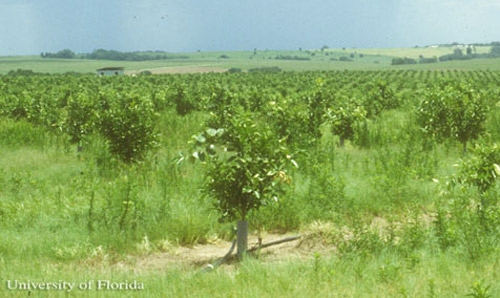
citrus weeds
Climate-Change Resources
University of California UC ANR Green Blog (Climate Change and Other Topics) https://ucanr.edu/blogs/Green/index.cfm?tagname=climate%20change (full index)
Examples:
- Save Trees First: Tips to Keep Them Alive Under Drought https://ucanr.edu/b/~CdD
- Landscaping with Fire Exposure in Mind: https://ucanr.edu/b/~G4D
- Cities in California Inland Areas Must Make Street Tree Changes to adapt to Future Climate https://ucanr.edu/b/~oF7
Drought, Climate Change and California Water Management Ted Grantham, UC Cooperative Extension specialist (23 minutes) https://youtu.be/dlimj75Wn9Q
Climate Variability and Change: Trends and Impacts on CA Agriculture Tapan Pathak, UC Cooperative Extension specialist (24 minutes) https://youtu.be/bIHI0yqqQJc
California Institute for Water Resources (links to blogs, talks, podcasts, water experts, etc.) https://ciwr.ucanr.edu/California_Drought_Expertise/
UC ANR Wildfire Resources (publications, videos, etc.) https://ucanr.edu/News/For_the_media/Press_kits/Wildfire/ (main website)
-UC ANR Fire Resources and Information https://ucanr.edu/sites/fire/ (main website)
-Preparing Home Landscaping https://ucanr.edu/sites/fire/Prepare/Landscaping/
UC ANR Free Publications https://anrcatalog.ucanr.edu/ (main website)
- Benefits of Plants to Humans and Urban Ecosystems: https://anrcatalog.ucanr.edu/pdf/8726.pdf
-Keeping Plants Alive Under Drought and Water Restrictions (English version) https://anrcatalog.ucanr.edu/pdf/8553.pdf
(Spanish version) https://anrcatalog.ucanr.edu/pdf/8628.pdf
- Use of Graywater in Urban Landscapes https://anrcatalog.ucanr.edu/pdf/8536.pdf
- Sustainable Landscaping in California https://anrcatalog.ucanr.edu/pdf/8504.pdf
Other (Non-UC) Climate Change Resources
Urban Forests and Climate Change. Urban forests play an important role in climate change mitigation and adaptation. Active stewardship of a community's forestry assets can strengthen local resilience to climate change while creating more sustainable and desirable places to live. https://www.fs.usda.gov/ccrc/topics/urban-forests
Examining the Viability of Planting Trees to Mitigate Climate Change (plausible at the forest level) https://climate.nasa.gov/news/2927/examining-the-viability-of-planting-trees-to-help-mitigate-climate-change/
Reports and other information resources coordinated under the auspices of the United Nations and produced through the collaboration of thousands of international scientists to provide a clear and up to date view of the current state of scientific knowledge relevant to climate change. United Nations Climate Action
Scientific reports, programs, action movements and events related to climate change. National Center for Atmospheric Research (National Science Foundation)
Find useful reports, program information and other documents resulting from federally funded research and development into the behavior of the atmosphere and related physical, biological and social systems. Search and find climate data from prehistory through to an hour ago in the world's largest climate data archive. (Formerly the "Climatic Data Center") National Centers for Environmental Information (NOAA)
Think tank providing information, analysis, policy and solution development for addressing climate change and energy issues (formerly known as the: "Pew Center on Global Climate Change"). Center for Climate & Energy Solutions (C2ES)
Mapping Resilience: A Blueprint for Thriving in the Face of Climate Disaster. The Climate Adaptation Knowledge Exchange (CAKE) was launched in July 2010 and is managed by EcoAdapt, a non-profit with a singular mission: to create a robust future in the face of climate change by bringing together diverse players to reshape planning and management in response to rapid climate change. https://www.cakex.org/documents/mapping-resilience-blueprint-thriving-face-climate-disaster
Cal-Adapt provides a way to explore peer-reviewed data that portrays how climate change might affect California at the state and local level. We make this data available through downloads, visualizations, and the Cal-Adapt API for your research, outreach, and adaptation planning needs. Cal-Adapt is a collaboration between state agency funding programs, university and private sector researchers https://cal-adapt.org/
Find reports, maps, data and other resources produced through a confederation of the research arms of 13 Federal departments and agencies that carry out research and develop and maintain capabilities that support the Nation's response to global change. Global Change (U.S. Global Change Research Program)
The Pacific Institute is a global water think tank that combines science-based thought leadership with active outreach to influence local, national, and international efforts to develop sustainable water policies. https://pacinst.org/our-approach/
Making equity real in climate adaptation and community resilience policies and programs: a guidebook. https://greenlining.org/publications/2019/making-equity-real-in-climate-adaption-and-community-resilience-policies-and-programs-a-guidebook/
Quarterly CA Climate Updates and CA Drought Monitor Maps (updated each Thursday) https://www.drought.gov/documents/quarterly-climate-impacts-and-outlook-western-region-june-2022
Drought focus of Water Resources IMPACT magazine special issue
UC ANR experts address emotional toll of drought
Preparing the American West for prolonged drought is the focus of a double issue of Water Resources IMPACT magazine. The California Water Commission staff are guest editors for this special open-access edition of the magazine, which is published by the American Water Resources Association.
Faith Kearns, academic coordinator of University of California Agriculture and Natural Resources' California Institute for Water Resources, is among the authors delving into how drought impacts people and the environment and how we can better prepare for the inevitable.
The first issue, published on Feb. 14, focuses on water scarcity issues confronting California and the ways these issues affect different sectors.
In “Trauma, Care, and Solidarity: Addressing the Emotional Toll of Chronic Drought,” Kearns highlights the effects of drought on mental health. She points to the spike in suicide hotline calls when wells ran dry in Southeast Asian communities in California's Central Valley.
By listening to Southeast Asian farmers, Ruth Dahlquist-Willard and Michael Yang of UC Cooperative Extension were able to “lighten the load” for them by providing pragmatic support, Kearns writes.
“The scale of some of these highly emotional issues – drought, wildfires, climate change – can make them seem incredibly difficult, if not impossible, to deal with,” Kearns said. “At the same time, they are affecting everyone living in the western U.S. on a daily basis. I wanted to highlight and provide models based on work that people – whether they are researchers, clinical psychologists, or Cooperative Extension advisors – are doing right now to ease the way.”
The authors who contributed to the double issue are a diverse array of Tribal experts, academics, nongovernmental organization thought-leaders, water managers and water policy influencers, each of whom brings their own perspective on the topic of drought. Their expertise and perspectives in climate science, water policy and water management will help inform drought-related decision-making and support policies that better prepare the state to thrive during periods of prolonged water scarcity.
In addition to Kearns, the first issue includes articles contributed by:
- Samantha Stevenson, University of California, Santa Barbara
- Jay Lund, University of California, Davis
- Ron Goode, North Fork Mono Tribe
- Andy Fecko, Placer County Water Agency
- Jeff Mount, Public Policy Institute of California, and Ted Grantham, University of California, Berkeley/UC Cooperative Extension
- Nat Seavy and Karyn Stockdale, National Audubon Society
- Kjia Rivers, Community Water Center
- Cannon Michael, Bowles Farming
- Michelle Reimers, Turlock Irrigation District
The January/February edition of Water Resources IMPACT magazine can be accessed, free of charge, on the American Water Resources Association website at https://www.awra.org under “Publications.”
The second issue, to be published in March, will focus on drought response, considering the options for adaptation. This two-part series complements the Commission's work on strategies to protect communities and fish and wildlife in the event of a long-term drought.
Your water-efficient landscape doesn’t have to be barren
UC climate-ready landscape trials identify low-water yet attractive plants
Good news: roses can be a part of your water-efficient landscape. Lorence Oki, UC Cooperative Extension environmental horticulture specialist in the UC Davis Department of Plant Sciences, identified rose cultivars that remain aesthetically pleasing with little water.
Oki is the principal investigator of the Climate-Ready Landscape Plants project, which may be the largest irrigation trial in the western U.S., and the UC Plant Landscape Irrigation Trials (UCLPIT), the California component of that project. These projects evaluate landscape plants under varying irrigation levels to determine their optimal performance in regions requiring supplemental summer water.
“There are some assumptions that pretty plants use a lot of water, like roses,” Oki said. “Everyone thinks they need a lot of water, but we've found some that don't, and they still look great. A water-efficient landscape doesn't need to look like a Central Valley oak-grassland in the summer. It can look really attractive.”
In 2021, Oki's team at UC Davis identified Lomandra confertifolia ssp. pallida "Pom Pom" Shorty and Rosa "Sprogreatpink" Brick House® Pink as two of the best low-water plants in the trial.
“The useful tip or information that is shared at the end of each trial is the selection and designation of plants as Blue Ribbon winners. These are the plants that looked good with an overall rating of 4 or higher throughout and were on the low (20%) water treatment,” said Natalie Levy, associate specialist for water resources, who manages the project at the UC ANR South Coast Research and Extension Center.
How plants earn a blue ribbon
Each trial year, the selection of new plants is based on research recommendations and donated submissions from the nursery industry. The landscape plants are trialed in full sun or 50% shade cover.
Irrigation treatments are based on the rate of evaporation and plant transpiration (evapotranspiration) measured through a local California Irrigation Management Information System (CIMIS) weather station that provides a reference evapotranspiration (ETo) rate.
Three levels of irrigation are provided to the plants equal to 20%, 50%, and 80% of ETo. The volume of water applied is the same at each irrigation based on soil characteristics, but the interval between applications varies with weather and the treatment. Using this method, irrigations for the 20% treatment are less frequent than the 80% treatment.
“The 20% treatment during the 2022 trial was irrigated an average of once per month while the 80% treatment was irrigated weekly,” explained Levy.
During the deficit irrigation trial, monthly height and width measurements are taken to determine the plant growth index. Monthly qualitative aesthetic ratings on a scale of 1 to 5 are determined for foliage appearance, flowering abundance, pest tolerance, disease resistance, vigor and overall appearance.
A second round of flowering abundance and overall appearance measurements are also taken to capture more of the blooming period. For example, UCLPIT identified in the 2020 trial at South Coast REC that the "Apricot Drift" rose had a mean overall appearance score of 3.5 out of 5, deeming it “acceptable to very nice” and a low water use plant within the Water Use Classification of Landscape Species or WUCOLS guide.
Project expands options for landscape planting
“(WUCOLS) only has 3,500 plants in it. There are guesses that there are close to 10,000 cultivars in urban landscapes in California, if not more,” said Oki. “WUCOLS also didn't have numerical ratings. Instead, you'll see verbal ratings like ‘low water use' or ‘high water use.'”
The UCLPIT project has not only developed numerical recommendations for irrigation, but it has also added new landscape plants that are compliant with California's Model Water Efficient Landscape Ordinance. In fact, UCLPIT's data is one of the few sources that can be used to supplement WUCOLS.
Geographic diversity of trial sites adds to knowledge base
In addition to UC Davis and South Coast REC in Irvine, the trials have expanded beyond California as the Climate-Ready Landscape Plants project and is in progress at Oregon State University, University of Washington, University of Arizona and Utah State University thanks to a USDA/CDFA grant awarded in 2020.
Lloyd Nackley, associate professor of nursery production and greenhouse management at Oregon State University, is the principal investigator of the trial in the Portland metro area, which is entering its third year.
“People know that there are drought tolerant plants, but there are many. We're trying to highlight lesser known or newer varieties. And even though the trial is three years, most gardeners would hope that their garden lasts longer than that,” said Nackley.
One of the observations that Nackley recalls is of the Hibiscus Purple Pillar plant. Unlike the trial at South Coast, the Purple Pillar did not perform well in Oregon in the spring.
“It wasn't until August that we saw the plant bloom and begin to look like what we saw from South Coast in April,” Nackley said.
Ursula Schuch, horticulture professor and principal investigator of the trial taking place at the University of Arizona, was also surprised at the range of performance among different plant types and the effects of irrigation, heat and temperature.
“This research will reassure green industry professionals that they can stretch their water budget to successfully cultivate more plants, watering them according to their needs instead of irrigating every plant according to the highest water-using plants,” said Schuch.
Although research is only conducted in the West, the hope is that there will be trials in other regions of U.S.
Doing so would yield comprehensive information about the plants and their performance in different climates. As extreme weather events persist in the U.S., disease pressure and risks do too. Trials throughout the country would provide location-specific data regarding disease susceptibility.
To learn more about the UCLPIT research project, visit https://ucanr.edu/sites/UCLPIT/

